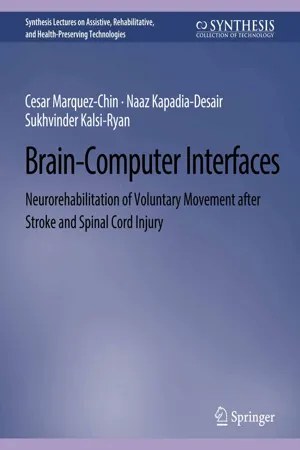
eBook - PDF
Brain–Computer Interfaces
Neurorehabilitation of Voluntary Movement after Stroke and Spinal Cord Injury
- English
- PDF
- Available on iOS & Android
eBook - PDF
Brain–Computer Interfaces
Neurorehabilitation of Voluntary Movement after Stroke and Spinal Cord Injury
About this book
Stroke and spinal cord injury often result in paralysis with serious negative consequences to the independence and quality of life of those who sustain them. For these individuals, rehabilitation provides the means to regain lost function. Rehabilitation following neurological injuries has undergone revolutionary changes, enriched by neuroplasticity. Neuroplastic-based interventions enhance the efficacy and continue to guide the development of new rehabilitation strategies. This book presents three important technology-based rehabilitation interventions that follow the concepts of neuroplasticity. The book also discusses clinical results related to their efficacy. These interventions are: functional electrical stimulation therapy, which produces coordinated muscle contractions allowing people with paralysis to perform functional movements with rich sensory feedback; robot-assisted therapy, which uses robots to assist, resist, and guide movements with increased intensity while also reducing the physical burden on therapists; and brain–computer interfaces, which make it possible to verify the presence of motor-related brain activity during rehabilitation. Further, the book presents the combined use of these three technologies to illustrate some of the emerging approaches to the neurorehabilitation of voluntary movement. The authors share their practical experiences obtained during the development and clinical testing of functional electrical stimulation therapy controlled by a brain–computer interface as an intervention to restore reaching and grasping.
Frequently asked questions
Yes, you can cancel anytime from the Subscription tab in your account settings on the Perlego website. Your subscription will stay active until the end of your current billing period. Learn how to cancel your subscription.
At the moment all of our mobile-responsive ePub books are available to download via the app. Most of our PDFs are also available to download and we're working on making the final remaining ones downloadable now. Learn more here.
Perlego offers two plans: Essential and Complete
- Essential is ideal for learners and professionals who enjoy exploring a wide range of subjects. Access the Essential Library with 800,000+ trusted titles and best-sellers across business, personal growth, and the humanities. Includes unlimited reading time and Standard Read Aloud voice.
- Complete: Perfect for advanced learners and researchers needing full, unrestricted access. Unlock 1.4M+ books across hundreds of subjects, including academic and specialized titles. The Complete Plan also includes advanced features like Premium Read Aloud and Research Assistant.
We are an online textbook subscription service, where you can get access to an entire online library for less than the price of a single book per month. With over 1 million books across 1000+ topics, we’ve got you covered! Learn more here.
Look out for the read-aloud symbol on your next book to see if you can listen to it. The read-aloud tool reads text aloud for you, highlighting the text as it is being read. You can pause it, speed it up and slow it down. Learn more here.
Yes! You can use the Perlego app on both iOS or Android devices to read anytime, anywhere — even offline. Perfect for commutes or when you’re on the go.
Please note we cannot support devices running on iOS 13 and Android 7 or earlier. Learn more about using the app.
Please note we cannot support devices running on iOS 13 and Android 7 or earlier. Learn more about using the app.
Yes, you can access Brain–Computer Interfaces by Cesar Marquez-Chin,Naaz Kapadia-Desai,Sukhvinder Kalsi-Ryan in PDF and/or ePUB format, as well as other popular books in Computer Science & Management. We have over one million books available in our catalogue for you to explore.
Information
Table of contents
- Cover
- Copyright Page
- Title Page
- Contents
- Acknowledgments
- Stroke, Spinal Cord Injury, and Neurorehabilitation
- Functional Electrical Stimulation Therapy: A Closer Look
- Robotic-Assisted Rehabilitation
- Brain–computer Interfaces
- The Intersection of Brain–computer Interfaces and Neurorehabilitation
- Implementation of a BCI-Triggered Functional Electrical Stimulation Therapy
- Concluding Remarks
- References
- Authors’ Biographies